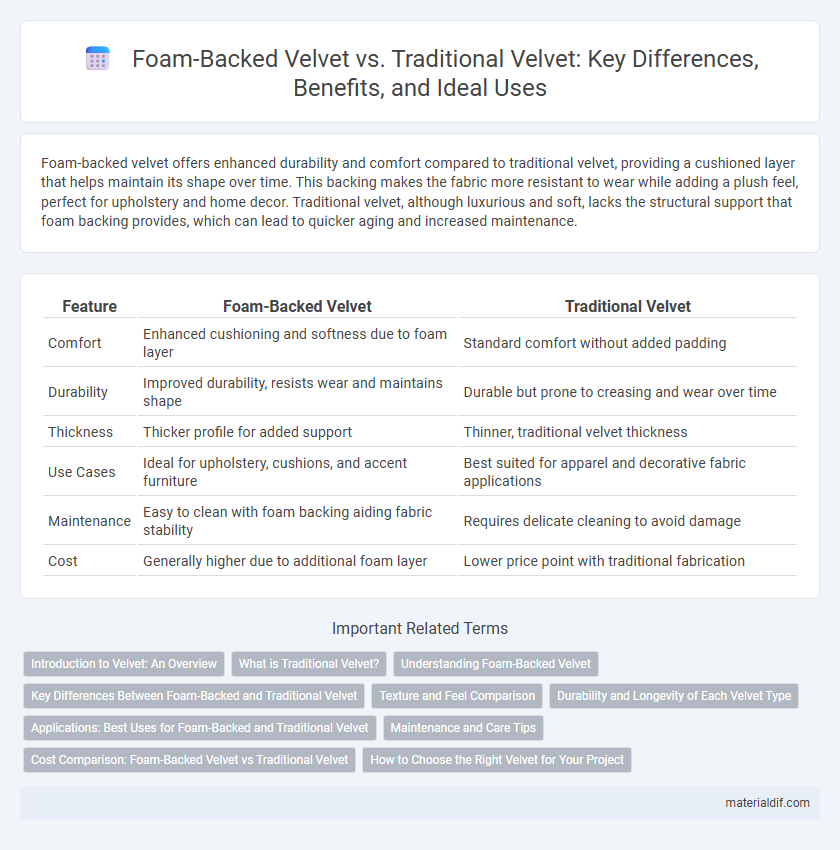Foam-backed velvet offers enhanced durability and comfort compared to traditional velvet, providing a cushioned layer that helps maintain its shape over time. This backing makes the fabric more resistant to wear while adding a plush feel, perfect for upholstery and home decor. Traditional velvet, although luxurious and soft, lacks the structural support that foam backing provides, which can lead to quicker aging and increased maintenance.
Table of Comparison
| Feature | Foam-Backed Velvet | Traditional Velvet |
|---|---|---|
| Comfort | Enhanced cushioning and softness due to foam layer | Standard comfort without added padding |
| Durability | Improved durability, resists wear and maintains shape | Durable but prone to creasing and wear over time |
| Thickness | Thicker profile for added support | Thinner, traditional velvet thickness |
| Use Cases | Ideal for upholstery, cushions, and accent furniture | Best suited for apparel and decorative fabric applications |
| Maintenance | Easy to clean with foam backing aiding fabric stability | Requires delicate cleaning to avoid damage |
| Cost | Generally higher due to additional foam layer | Lower price point with traditional fabrication |
Introduction to Velvet: An Overview
Foam-backed velvet features a cushioned layer providing enhanced durability and comfort compared to traditional velvet, which consists solely of a woven pile fabric. This foam layer improves insulation and resistance to wear, making foam-backed velvet ideal for upholstery and high-traffic areas. Traditional velvet, prized for its luxurious texture and rich appearance, remains a popular choice for garments and decorative applications where softness and elegance are paramount.
What is Traditional Velvet?
Traditional velvet is a luxurious fabric characterized by its dense pile of cut fibers that create a soft, smooth texture with a rich color depth. It is typically made from natural fibers like silk or cotton, offering a classic sheen and a heavy drape ideal for upholstery, drapery, and high-end fashion. The intricate weaving process of traditional velvet produces a fabric that is durable yet delicate, prized for its timeless elegance and tactile appeal.
Understanding Foam-Backed Velvet
Foam-backed velvet features a layer of foam attached to the rear side of the fabric, providing enhanced cushioning and durability compared to traditional velvet. This added foam layer improves sound insulation and adds a plush, structured feel, making it ideal for upholstery and drapery applications. Unlike traditional velvet, foam-backed velvet resists crushing and maintains its luxurious texture even with frequent use.
Key Differences Between Foam-Backed and Traditional Velvet
Foam-backed velvet features a cushioned layer that enhances durability, comfort, and insulation, making it ideal for upholstery and heavy-use applications. Traditional velvet, woven from silk or cotton without additional backing, offers a softer, more delicate texture but is less resistant to wear and lacks the support provided by foam. The key differences lie in foam-backed velvet's structural support and longevity versus traditional velvet's natural softness and elegance.
Texture and Feel Comparison
Foam-backed velvet offers a plush, cushioned texture that enhances softness and provides added durability, making it ideal for upholstery and high-traffic furniture. Traditional velvet features a smoother, more delicate surface with a luxurious feel but is less resilient to wear and pressure. The foam backing significantly improves the tactile experience by adding support beneath the velvet pile, resulting in a richer and more substantial touch.
Durability and Longevity of Each Velvet Type
Foam-backed velvet offers enhanced durability and longevity compared to traditional velvet due to its additional cushioning layer that reduces fabric wear and tear over time. This backing helps maintain the velvet's texture and appearance by providing extra support against stretching and abrasion. Traditional velvet, while luxurious, tends to be more susceptible to crushing and fading without the reinforcement foam backing provides.
Applications: Best Uses for Foam-Backed and Traditional Velvet
Foam-backed velvet is ideal for upholstery applications requiring enhanced durability and cushioning, such as sofas, armchairs, and headboards, providing added comfort and structural support. Traditional velvet excels in drapery, apparel, and decorative accents where softness, rich texture, and elegant appearance are prioritized without the need for extra padding. Both materials offer distinct advantages depending on whether the project demands resilience and comfort or a lightweight, luxurious finish.
Maintenance and Care Tips
Foam-backed velvet offers enhanced durability and easier maintenance compared to traditional velvet, as the foam backing prevents excessive stretching and wrinkling during cleaning. To preserve foam-backed velvet, vacuum regularly with a soft brush attachment and spot-clean stains promptly using mild soap and water, avoiding excessive moisture. Traditional velvet requires more delicate handling, including professional cleaning for deep stains and gentle brushing to maintain its rich texture without damaging the fibers.
Cost Comparison: Foam-Backed Velvet vs Traditional Velvet
Foam-backed velvet typically costs more than traditional velvet due to the added foam layer that enhances durability and cushioning. While traditional velvet offers a classic texture and appearance at a lower price point, foam-backed velvet delivers improved structural integrity and longevity, which can justify the higher initial investment. Budget considerations should weigh both upfront cost and the potential for extended product lifespan when choosing between these velvet types.
How to Choose the Right Velvet for Your Project
Foam-backed velvet offers enhanced durability and cushioning, making it ideal for upholstery projects requiring extra comfort and longevity. Traditional velvet provides a smooth, luxurious texture preferred for drapery and decorative accents where softness is paramount. Selecting the right velvet depends on the specific application, where foam-backed velvet suits heavy-use furniture while traditional velvet excels in aesthetic-focused designs.
Foam-Backed Velvet vs Traditional Velvet Infographic

 materialdif.com
materialdif.com